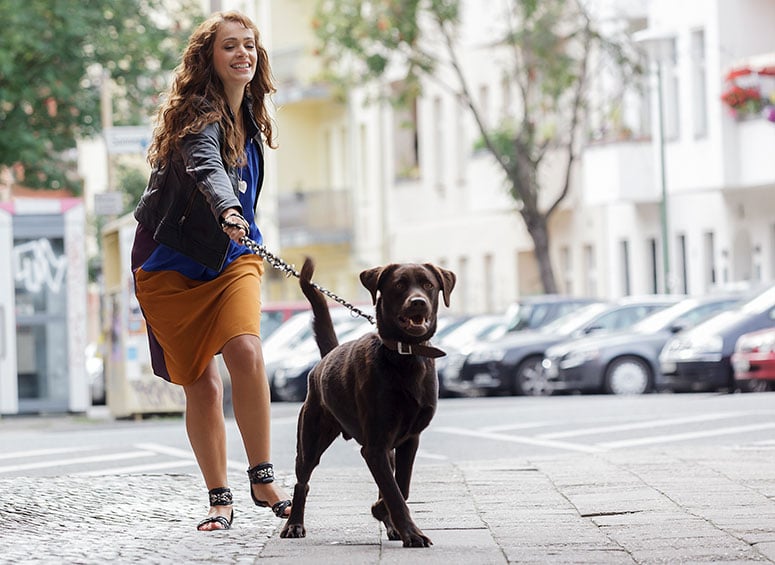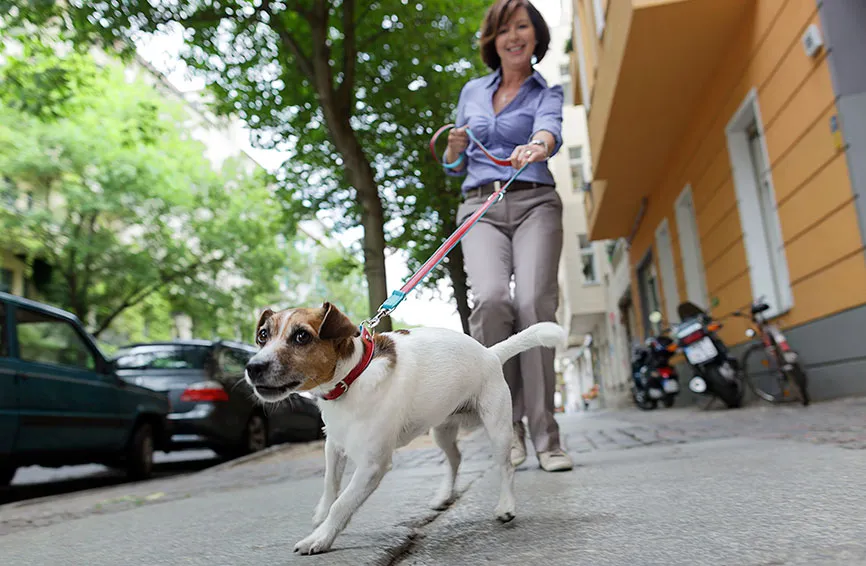Table of Contents
If you have a dog who is trying to chase cars, walks can be very stressful for you and your pup. Not to mention the obvious danger to your dog and any motorists should he get loose.
There is no quick fix, but with some work, you can train a dog not to chase moving vehicles.
Why do some dogs chase cars?
You may be confused, wondering why your dog would chase something that could injure or even kill them so easily. It’s important to remember that dogs don’t understand dangers, they are just triggered to chase, and their prey drive is what’s causing this dangerous behavior. It’s the same instinct that causes many dogs to chase chipmunks, squirrels, and other critters and lunge after skateboards, bikes or anything else on wheels.
How to walk your dog as you address the car-chasing behavior
You will first want to stop walking your dog on a sidewalk with cars passing. You will not be able to make any progress in this scenario.If cars are constantly triggering your dog, before you change their emotional and physical reaction to vehicles, they will continue to be in a heightened prey-drive state of mind on walks. With any high-intensity behavior, the key to success is taking baby steps as you slowly change their mind, and, eventually, their emotional response. It could take months to reach your goal, but all your patience, time, and dedication will be worth it.
Where to walk your dog as you work on training
As you work on helping your dog understand that car-chasing is unacceptable, drive to an area outside of town and walk your dog in nature, where they aren’t exposed to vehicles passing by. This will help your dog learn to feel more relaxed during their walk, which will help them in the future when you introduce them to walking along a sidewalk again. If they are immediately stressed when they see the leash and automatically expect to chase vehicles, you’ve lost before you’ve started.
How you feel affects your dog’s behavior on walks
If you have been dreading every walk because it’s such a struggle and so scary to walk your dog when they react by lunging at passing cars, you are most likely amped up before you head out of the door too. This contributes to your dog’s behavior.
If they feel you are stressed and afraid, therefore not in charge of the walk, your dog will not respond to your pleas to stop lunging at cars. Changing your walks up and taking them somewhere safe and peaceful will make your heart rate normal rather than elevated.
When you enjoy the walk and feel calm and confident, this energy travels down the leash to your dog and affects their emotional state and behavior. Creating a new relaxed reaction to walks with you will help you both as you take steps towards changing your dog’s behavior towards cars.

How to prepare for your training session
Your first training session will not be on a walk but right at home. Before you begin, put your dog’s bed on the front porch and have a couple of favorite toys available or a bone (if they are not bone possessive). It’s important they have something to entertain themselves, and chewing can help relieve any anxiety they may feel. Keep high-value treats on hand. Your dog should have a regular collar, not a choke chain, shock collar, or prong collar. It’s essential to see their natural reaction without suppressing it due to fear of being hurt.
- Start by sitting on your front porch with your dog on a leash, keeping the leash slack, but having a firm hold on the handle. Your dog should be able to move around but not go too far.
- Don’t look at them or talk to them; just let them settle on their own.
- If they bark or lunge at a passing car, calmly say “leave It” and their name. Only say it once.
- Wait 10 seconds; if they don’t stop, take them to a time-out room for three minutes. (See below for more about a time-out room).
- If they stop the barking and lunging, even for a moment to look at you, say “good leave it” and say their name as you give them a high-value treat.
Repeat this process and keep training sessions short at first, 5-10 minutes. Even with a few cars passing by, you are asking your dog to use a lot of self-control. Shorter sessions make it easier for your dog to get it right.
Once your dog isn’t reacting to cars passing by while sitting on your porch, it’s time to increase the challenge – see step 2 below.
How to create a time-out space and how to use it
The time-out room needs to be small, like the laundry room or bathroom. It’s also important not to put them in their crate, as this should always be your pup’s safe space. Also, don’t take them to a room they are afraid of.
Escort your dog to the time-out space without looking or talking to them, and remain calm. Don’t scold them as you take them to a time-out– that would give them attention for their reaction, making it worse.
Remove the leash again without looking or talking to them, and ensure the light is on once they are in the room. Leave them in the room for three minutes by themselves and walk to another room while you wait.
After three minutes, walk toward the time-out room, and if they are quiet, walk into the room without acknowledging them. If they are barking/whining/scratching on the door, wait until they stop for a moment, then open the door and go inside the room.
Once inside the room, sit down, but not on the floor, as that is an invitation to come over for affection. If they come over to you, push them out of your space. Imagine having a two-foot bubble around you, and if they invade that space, they are checking to see if you own your space. So, if you don’t push them away without acknowledgment, they don’t get the comfort they seek. If you own your space, your dog will learn to trust you.
Once they have stopped looking at you and trying to ‘burst your bubble,’ call them to you with a friendly, calm voice. Praise them for coming to you when invited, clip the leash back on, and walk back towards the front porch.
Give your dog the same grace, understanding, and patience you would a two-year-old child as they learn. They deserve a ‘fresh slate’ after every time-out. This will only contribute to their behavior if you are getting frustrated or annoyed at them. You must remain the grounded, confident, and calm leader they can follow during training.
Step 2: Moving closer to the trigger
Move closer to the sidewalk from your porch and continue the same training protocol. It’s best if you are sitting because you are showing your dog that you are feeling more relaxed. Move their dog bed and toys, too, so they are still available to your dog. The only instance this isn’t advised is if your dog is possessive of their toys. You want to avoid any potential for a fight with a dog walking past on a leash.
Once your dog is exhibiting great self-control and not reacting to cars passing by as you sit closer to the road, you are ready for the next step.
Step 3: Start walking
Walk back and forth in front of your home. As you do this, use “leadership walking,” where you don’t speak to or look at your dog. If they walk in front of you, turn around and walk in the opposite direction for a few steps, then wait 10 seconds before walking again. Every time they respond to a car, continue the “leave it” request and time-out techniques. It’s crucial to stay very close to home at first so if you need to escort them to a time-out, you can take them quickly; otherwise, they won’t associate the isolation with their response to cars.
Once your dog isn’t responding to cars, or if they do, they always respond to ‘leave it’ immediately, and then re-set quickly and follow your lead, you are ready for the next step.
Step 4: Leaving home
Start to venture away from home, slowly increasing how far you go and how long you walk. If your pup is struggling, go back to the last step. Consistently implement the “leadership walking” as a reminder that you are in charge, so they will continue to look to you for guidance and be more likely to respond to your requests.
Tips for training
Remember: Every dog will learn at their own pace, and it’s important not to put any pressure on yourself or your dog to ‘hurry up and get over it .’ Keep in mind that their reaction is instinctual, and it will take time to change their behavior.
What is leadership walking? As you walk, don’t look at or talk to your dog, This will help your dog see you as the decision-maker. If your dog starts to walk in front of you, turn around and walk back in the other direction for five steps, stop, wait about 10 seconds, and begin walking again. Repeat this process while remaining patient and calm. By walking your dog using this protocol, you are helping your dog learn that you are leading them and helping them learn how to be calm. With repetition, they will realize that they aren’t going anywhere until they follow your lead, which allows them to build trust in your ability to make decisions, and they will be more apt to respond when you ask them to “leave it.”
Why are time-outs effective? When a dog makes a mistake in the canine world, the pack shuns them, and this helps them to realize that they made a mistake. It’s much more effective than raising your voice or using pain-based training techniques, which cause more stress for dogs. As they are separated from you for a few minutes, they are processing and learning that this behavior isn’t acceptable.
Why is it essential to not acknowledge your dog sometimes? The less attention you give your dog, the more they will change their mind about who’s in charge. If you are looking at them, talking to them, and giving them affection as you train, the less they will feel supported by you. This feels counter-intuitive but remember, dogs look for comfort and guidance in different ways than children do. If you are engaging with them a lot, from their perspective, you are looking to them for guidance. So, when you remind them to ‘leave it’ they will be less likely to respond to you.







